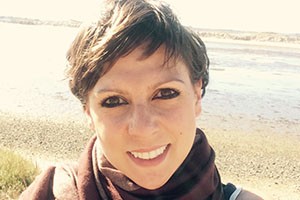Saturday, May 21, 2016
Thursday, May 19, 2016
Projeto sobre o Tarrafal vale prémio internacional a estudante da FLUP
É a primeira vez que um projeto português vence este concurso. Foi no dia 5 de abril que Marzia Bruno recebeu o telefonema de Nova Iorque, mas diz que ainda hoje não consegue acreditar… “Não consigo descrever a felicidade”, diz esta italiana, a frequentar o Doutoramento em História de Arte da Faculdade de Letras da Universidade do Porto (FLUP). Entre as 423 candidaturas enviadas por 53 países, o júri do apexart International Franchise Program 2016-17, composto por 200 elementos de todo o mundo, selecionou quatro propostas, mas foi a de Marzia que ficou em primeiro lugar. O projeto de curadoria chama-se “A Glimmer of Freedom”, o que se poderá traduzir por “Um lampejo de Liberdade” e vai concretizar-se no próximo ano no Campo do Tarrafal, em Cabo Verde.
Marzia Bruno é italiana. E foi em Florença que concluiu o curso de Belas Artes. Em 2005 veio para Portugal ao abrigo do Programa Erasmus e foi aí que todo o percurso de vida mudou. Decidiu que seria na Faculdade de Belas Artes da Universidade do Porto que faria o seu Mestrado em Estudos Artísticos, com especialização em Estudos Museológicos e Curadoriais. Foi ficando por cá, trabalhou no Museu de Aveiro e, já com uma bolsa da FCT, aventurou-se no Doutoramento em História de Arte da FLUP. Porque não em Florença? “Porque a decisão de fazer o doutoramento em Itália seria óbvia. Um dado adquirido. E o meu interesse é por culturas novas”, diz.
O projeto de curadoria que lhe valeu este prémio internacional nasceu de uma visita realizada a Cabo Verde em 2014. Foi durante essa visita que percebeu o interesse da valorização histórica deste lugar que entre 1936 e 1954 abrigou presos políticos portugueses. “A Colónia Penal do Tarrafal ficou conhecida como o ‘Campo da Morte Lenta’ justificado pelas péssimas condições climáticas, saúde, alimentação e um regime prisional marcado por um extrema violência. Mais tarde, de 1962 a 1974, sob o novo nome – ‘Campo de Trabalho de Chão Bom’ – foi usada para aprisionar líderes das guerras pela independência em Cabo Verde, Angola e Guiné-Bissau. No total foram lá presos mais de 340 antifascistas portugueses e cerca de 230 nacionalistas africanos”, recorda Marzia
Atualmente, as instalações do Tarrafal preservam a estrutura arquitetónica das celas e as grades originais das celas de tortura. O projeto de Marzia Bruno pretende fazer o levantamento dos prisioneiros que estiveram no campo, entrevistar os que ainda se encontram vivos e desafiar os artistas locais a apresentarem propostas
“Os relatos de histórias pessoais das pessoas e o espaço físico são um legado do colonialismo e pretendem ser um veículo para a reflexão deste projeto curatorial. O nome Tarrafal, por si só, refere-se à Luta e Liberdade, e a exposição irá explorar a visão dos artistas sobre estas questões, articulando o espaço físico com questões contemporâneas. Relacionando-se com a memória do espaço, quatro artistas serão desafiados a criar obras de “Land Art”, técnica também conhecida como “Earth Art” ou “Earthworks”, na paisagem envolvente, dentro dos limites de prisão”, explica a estudante na proposta submetida a concurso
A decorrer entre abril e maio de 2017, a exposição irá reunir várias instalações “site-specific”, no interior das celas, enquanto as paredes exteriores irão exibir mapeamentos de projeção digital (“Video Mapping” ou ” Projection Mapping”). Espaços como o refeitório, a enfermaria ou a cela “frigideira” (a forma mais atroz de punição perpetrada no Campo) serão os espaços que servirão de inspiração ao trabalho dos artistas. Estas instalações serão produzidas com materiais locais, os efeitos sonoros e os mapeamentos de projeção irão ser utilizados na manipulação do espaço. Em simultâneo, serão levadas a cabo iniciativas como música tradicional, dança, narração de histórias, mesas redondas com ex-prisioneiros e atividades com as comunidades escolares locais.
As propostas vencedoras (na edição deste ano – a nona de sempre – houve quatro) recebem um financiamento que pode ascender aos 10 mil dólares e apoio administrativo para a sua implementação no terreno. O projeto “Um Lampejo de Liberdade” venceu na categoria “Programa Franquia”.
Friday, April 29, 2016
Literature
This Infographic Unearths the Truth Behind Famous Literary Pseudonyms
A new infographic goes from Charles Dickens to JK Rowling to reveal the pseudonyms of famous authors and the reasons behind many of them.
[Photo: Everett Historical via Shutterstock]
JOE BERKOWITZ 04.27.16 11:07 AM
"What's in a name? That which we call a rose by any other name would smell as sweet." William Shakespeare famously wrote in Romeo and Juliet. Of course, the bard's actual identity has long been in dispute,leaving us to ask wonder whether his plays would read as well if they came from a name that hadn't accrued centuries of inherent significance. A new infographic plays the literary name game with some of the other most famous authors of all time by revealing the true identity of several pseudonyms.
Created by U.K.-based rare book depot, Jonkers, The Author Behind The Pseudonym drops the actual names of many authors, along with the reasons behind the obfuscation. In some instances, the author used anom de plume at the time of publication, but has since gone on to worldwide renown under their actual names, like Charles Dickens, who once wrote as the mononymous Boz. Others wrote under a pen name their whole career, like Mark Twain, with many not realizing their actual names (in his case, Samuel Clemens.) But those examples are for amateurs. The infographic digs further and unearths alternate names for Patricia Highsmith, C.S. Lewis, Lewis Carroll, and many more.
Have a look at the infographic below, and let us know in the comments about any glaring absences.
Retriever from www. Fastcreat.com
